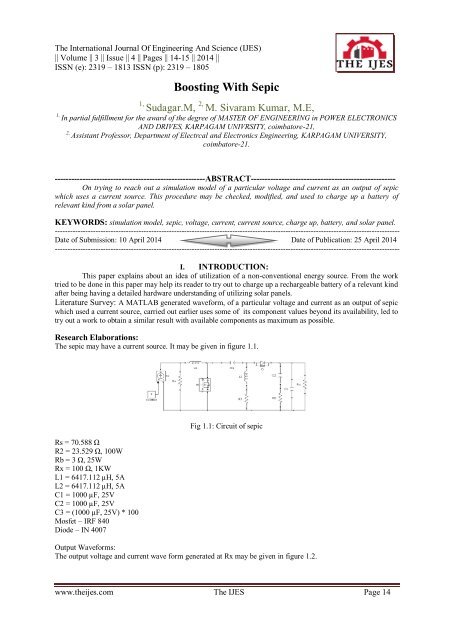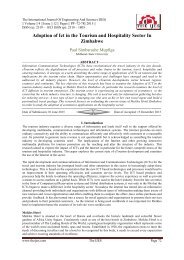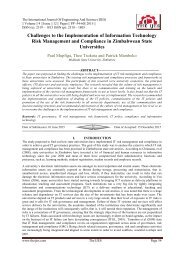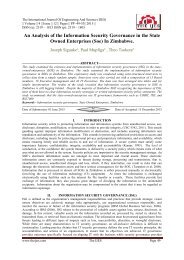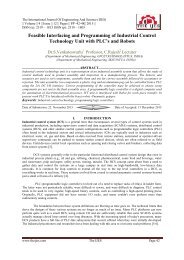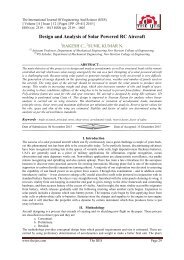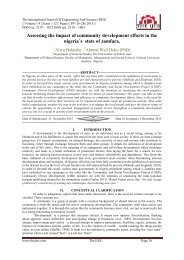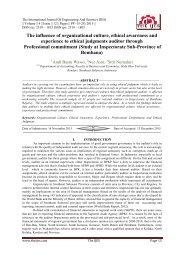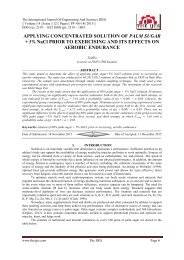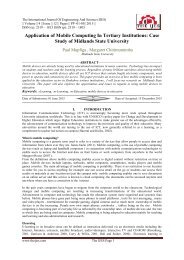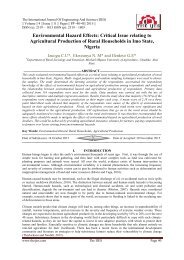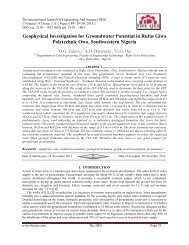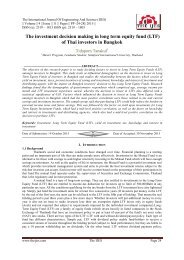Boosting With Sepic
You also want an ePaper? Increase the reach of your titles
YUMPU automatically turns print PDFs into web optimized ePapers that Google loves.
The International Journal Of Engineering And Science (IJES)<br />
|| Volume || 3 || Issue || 4 || Pages || 14-15 || 2014 ||<br />
ISSN (e): 2319 – 1813 ISSN (p): 2319 – 1805<br />
<strong>Boosting</strong> <strong>With</strong> <strong>Sepic</strong><br />
1,<br />
Sudagar.M, 2, M. Sivaram Kumar, M.E,<br />
1,<br />
In partial fulfillment for the award of the degree of MASTER OF ENGINEERING in POWER ELECTRONICS<br />
AND DRIVES, KARPAGAM UNIVRSITY, coimbatore-21,<br />
2,<br />
Assistant Professor, Department of Electrcal and Electronics Engineering, KARPAGAM UNIVERSITY,<br />
coimbatore-21.<br />
------------------------------------------------------ABSTRACT----------------------------------------------------<br />
On trying to reach out a simulation model of a particular voltage and current as an output of sepic<br />
which uses a current source. This procedure may be checked, modified, and used to charge up a battery of<br />
relevant kind from a solar panel.<br />
KEYWORDS: simulation model, sepic, voltage, current, current source, charge up, battery, and solar panel.<br />
----------------------------------------------------------------------------------------------------------------------------------------<br />
Date of Submission: 10 April 2014 Date of Publication: 25 April 2014<br />
----------------------------------------------------------------------------------------------------------------------------------------<br />
I. INTRODUCTION:<br />
This paper explains about an idea of utilization of a non-conventional energy source. From the work<br />
tried to be done in this paper may help its reader to try out to charge up a rechargeable battery of a relevant kind<br />
after being having a detailed hardware understanding of utilizing solar panels.<br />
Literature Survey: A MATLAB generated waveform, of a particular voltage and current as an output of sepic<br />
which used a current source, carried out earlier uses some of its component values beyond its availability, led to<br />
try out a work to obtain a similar result with available components as maximum as possible.<br />
Research Elaborations:<br />
The sepic may have a current source. It may be given in figure 1.1.<br />
Rs = 70.588 Ω<br />
R2 = 23.529 Ω, 100W<br />
Rb = 3 Ω, 25W<br />
Rx = 100 Ω, 1KW<br />
L1 = 6417.112 µH, 5A<br />
L2 = 6417.112 µH, 5A<br />
C1 = 1000 µF, 25V<br />
C2 = 1000 µF, 25V<br />
C3 = (1000 µF, 25V) * 100<br />
Mosfet – IRF 840<br />
Diode – IN 4007<br />
Fig 1.1: Circuit of sepic<br />
Output Waveforms:<br />
The output voltage and current wave form generated at Rx may be given in figure 1.2.<br />
www.theijes.com The IJES Page 14
Boostig <strong>With</strong> <strong>Sepic</strong><br />
Fig.1.2: Output Voltage and Current Wave forms<br />
The pulse wave form may be given in figure 1.3.<br />
Fig.1.3: Firing pulse given to sepic<br />
Result and Discussion:<br />
A 5V, 5600mAh (Li-ion) rechargeable battery may be tried to be charged (1/100 th of the rated current is output<br />
of this sepic), may be understood from the MATLAB generated waveform after being having a detailed<br />
hardware understanding of utilizing solar panels. As the circuit uses sepic, it may be replaced by zeta to try out<br />
to obtain a similar output.<br />
Conclusion:<br />
This paper opens up a way to obtain a particular result. This paper, only helps its reader for a better<br />
understanding, to try out a work of a similar kind.<br />
REFERENCES:<br />
[1] D. Jc Mac Kay, Sustainable Energy without the Hot Air,(UIT Cambridge,England, 2009).<br />
[2] R.B.Darla, Development of maximum power point tracker for PV panel using SEPIC converter, Tele communications Energy<br />
Conference, 2007, sept.30-oct.4.<br />
[3] D.Morales, Maximum Power Point Tracking Algorithm for photovoltaic Applications, Thesis for the Degree of Master of<br />
Science,Aalto University ,Finland ,2010.<br />
[4] S.Poshtkouhi,V.Palaniappan and M.Fard, O.Trescases, IEEE Transactions on Power Electronics, Vol. 27, 2012, 4656-4666.<br />
[5] G.Walker, Evaluating MPPT converter topologies using a matlab PV model, J. Elect. Electron. Eng., Vol. 21, 2001, 45–55.<br />
[6] D. Archer, R. Hill, Clean electricity from photovoltaics, Series on Photoconversion of Solar Energy, (Imperial College Press,2001).<br />
[7] H.L. Tsai, Ci-Siang Tu and Yi-Jie Su, Development of Generalized Photovoltaic Model Using Matlab/Simulink, The World<br />
Congress on Engineering and Computer Science,USA , 2008,22-24 October.<br />
[8] W. DeSoto, S.A.Klein and W.A.Beckman, Improvement and Validation of a model for photovoltaic Array Performance, Elsevier<br />
Solar Energy, 2006, Vol.80,No.1, 78-88.<br />
[9] M. G. Villalva, J. R. Gazoli, and E. R. Filho, Comprehensive approach to modeling and simulation of photovoltaic arrays, IEEE<br />
Trans. PowerElectron, Vol. 24, No. 5, 2009, 1198–1208.<br />
[10] M.villavla, J.Gazoli,and E.Filho, Comprehensive approach to modeling and simulation of photovoltaic Arrays, IEEE Trans .on<br />
Power Electronics , Vol.24,No.5, 2009, 1198-1208.<br />
www.theijes.com The IJES Page 15


